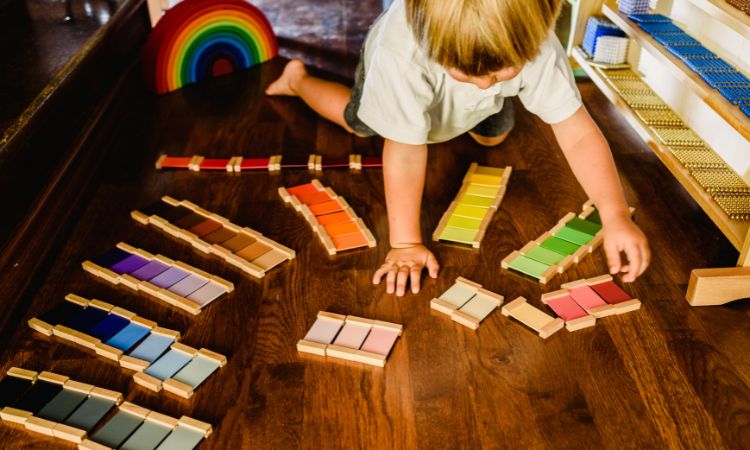Colours are an important element of our life, from the clothes we wear to the food we eat. It’s usually a thrill for parents to observe their child’s interest and excitement as they begin to see new colours around them.
However, have you ever wondered when your child will begin to recognise and learn colours?
It’s a critical developmental milestone, and in this post, we’ll delve into the interesting world of when kids learn colours. So strap in, and let’s get started!
Developmental Stages Of Learning Colours
Stage 1: From birth to 6 months
- Infants primarily establish fundamental colour perception and respond to contrasting colours at this stage.
- While newborns cannot differentiate between different colours, they can detect light and dark contrasts.
- Most children begin to sense primary colours, such as red, blue, and yellow at the age of 2 to 3 months.
Stage 2: 6 to 12 months
- Infants begin to learn colour names and categorize them in the second stage.
- They begin to recognise colours regularly and associate them with their related names. For instance, when presented with a red ball and asked, “What colour is this?” they may respond, “Red.”
- They also begin to classify objects by colour as they get older.
Stage 3: lasts 12 to 36 months.
- Toddlers can recognise and name colours independently at this age.
- They understand colour and can accurately label a variety of hues.
- They also begin to employ colour terms to describe objects and events in their environment, such as “blue car” or “yellow sun.”
- Toddlers are captivated by colour sorting and can spend hours categorising their toys, blocks, or other items based on their colours.
Note:- It’s crucial to remember that these are just estimates and that each child develops at their own pace.
Also Read – All You Need To Know About Co-Parenting Custody in 2023
Factors Affecting Color Learning
Nature against Nurture
Nature refers to the hereditary components that determine colour perception, whereas nurture refers to the contextual forces that shape this perception.
Genetics
Some youngsters may be predisposed to a higher or poorer capacity to sense colours based on their genetics.
Children with specific types of colour blindness, for example, may suffer from colour learning due to a genetic impairment in colour vision.
Colour perception development can be influenced by genetics in a variety of ways.
- Some genetic mutations can cause colour blindness or reduced colour vision, making colour learning more difficult.
- According to research, genetics may also play a part in determining colour sensitivity, with some people being more sensitive to certain colours than others.
The Environment
Environmental influences, on the other hand, play an important part in colour learning. Children who grow up in an atmosphere with colourful toys, books, and decorations, for example, may learn colours more easily than those who do not.
Colour exposure in daily life can assist in reinforcing colour learning and make it more natural for youngsters to detect and differentiate between different colours.
Environmental influences, particularly during the key period of early development, can substantially impact colour learning.
- For example, presenting youngsters with diverse, colourful toys and activities can aid in colour learning.
- Colour learning can also be aided through exposure to various colours in the natural environment, such as trees, flowers, and animals.
Learnings Styles
The way a child learns colours affects their ability to understand them.
Visual Learners
Colours, drawings, and diagrams are common visual aids used by visual learners to help them learn and recall new information.
When it comes to learning colours, visual learners may benefit from activities such as flashcards or picture books that entail looking at and identifying coloured items.
Kinesthetic learners
Kinesthetic learners, on the other hand, prefer a hands-on learning style. They learn best through physical movement and object interaction.
When it comes to learning colours, kinesthetic learners may benefit from activities such as sorting and matching coloured objects or playing games that require moving and arranging coloured things.
Ways To Teach colours To Students
Using everyday objects to teach colours to young children is a good method since it allows them to learn while they play and explore their surroundings.
Here are some examples of how to teach colours using household items and toys.
Household Items
- Colours can be taught using everyday household items like fruits, vegetables, and clothing.
- You could, for example, offer your child a red apple and remark, “This apple is red.” Other fruits and vegetables, such as bananas, oranges, and broccoli, can be treated in the same way.
- You can also show them different items of clothes, such as a red shirt, blue trousers or yellow socks.
Toys
Toys are an excellent approach to teaching colours because they are entertaining and engaging.
- They also assist your youngster in discovering colours, using building blocks, puzzles, and stacking toys.
- For example, you could instruct your youngster to stack red blocks on top of each other or to match the colours on the puzzle.
- Colours can also be taught using toy cars, balls, and other objects.
Interactive Gaming
Colour teaching through interactive learning apps and games is becoming increasingly popular among parents and educators.
Apps And Games
These applications and games help youngsters learn colours in a fun and engaging way by involving them in tasks such as matching colours, colouring pictures, and identifying items of a specific colour.
Songs And Rhymes
Colours can also be taught to young children through songs and rhymes.
- Many nursery rhymes and children’s songs include colour lyrics, making it simple for children to remember and learn colours through repetition.
- Colour songs that are well-known include “I Can Sing a Rainbow” and “The Colour Song.”
Also Read – Cost of Divorce in Indiana: Everything You Need to Know
Engaging In Art Activities
Hands-on activities such as finger painting, colouring books, and craft projects are another enjoyable approach to teaching children colours.
These exercises assist youngsters not only in learning colours but also in improving their motor skills, creativity, and imagination.
Finger Painting
Finger painting is an excellent hobby for young children since it allows them to explore and blend colours with their fingertips.
It enables users to design their own colour schemes and experiment with various tones and hues.
Colour Books
Colouring books are another popular way to teach colours. Colouring in pictures can help children learn to recognise different colours and be a soothing and calming hobby.
Craft Projects
Craft projects are another enjoyable way for children to learn about colours. They help children make their own colourful creations with materials like paper, paint, and glue.
This might be an excellent opportunity for children to learn about various colour combinations and how they can be utilised to achieve various effects.
Overall, hands-on activities can help toddlers learn colours in a more interesting and memorable way.
Red Flags In Color Learnings
Delayed Color Learning
While most children learn colours naturally and easily, some children may experience delayed colour learning.
Parents and carers must know the warning signs and seek expert assistance if necessary.
Among the possible causes of delayed colour learning are:
- Children with developmental delays may take longer to learn colours and other developmental milestones.
- Children with vision issues may have difficulties discriminating between different colours.
- Language delays can make it difficult for children to learn colour names and create relationships between colours and their names.
When to seek professional help?
- Lack of colour interest: If your child displays no interest in colours or does not appear to notice them, this could be an indication of delayed colour learning.
- Colour identification difficulty: If your child continuously struggles to recognise colours, even after repeated exposure, this could be an indication of delayed colour learning.
- Struggles with other developmental milestones: If your child has difficulty with other developmental milestones, such as language development or fine motor abilities, this could indicate a broader developmental delay.
Colour Blindness
Colour blindness, also known as colour vision deficit, is a condition in which a person cannot differentiate specific colours or cannot see them at all.
Red-green colour blindness is the most prevalent type of colour blindness, which implies the person has difficulty discriminating between red and green hues.
Colour blindness symptoms can include:
- Difficulty differentiating between some colours, particularly red and green tones.
- Colours appear bland or bleached out.
Unfortunately, there is no treatment for colour blindness at the moment, but there are ways to manage and help those who have it.
- Using assistive technologies to improve colour perception, such as colour filters or special glasses
- Making changes to the surroundings to make it more navigable, such as employing high-contrast colours for signs and labelling.
- Educating others about the disease in order to eliminate misinformation and discrimination
- Individuals with colour blindness must receive a diagnosis and appropriate support to help them navigate their surroundings.
Also Read – How a Mother Can Lose a Custody Battle?
Conclusion
Colour recognition is an important element of a child’s development. It is a long process that progresses from fundamental colour perception to independently identifying and naming colours.
It is also critical to recognise red flags in colour learning, such as delayed colour learning or colour blindness, and to seek expert assistance when necessary.
Finally, teaching children colours can be an enjoyable and gratifying experience that sets the stage for a lifetime of learning.




